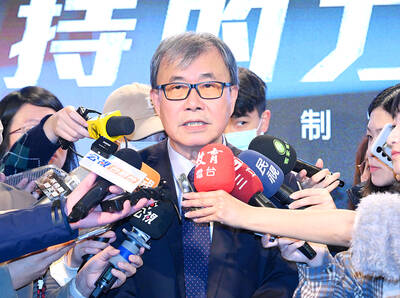Tensions between China and Japan bumped back up a notch yesterday when Tokyo asked Beijing to pay for damages to patrol boats hit by a Chinese fishing vessel in disputed waters, countering China’s demand for an apology over the incident.
The diplomatic back-and-forth shows that nationalistic sentiments stirred up by the incident — and the territorial dispute behind it — are not fading even after Tokyo released the captain on Friday amid intense pressure from China.
Welcoming the skipper home as a hero, China stunned Japan over the weekend by demanding an apology and compensation for his arrest, a move that reflects Beijing’s growing self-confidence and its attempts to test the resolve of key neighbors such as Japan, Washington’s closest ally in the region.
Criticized at home for caving in to Chinese pressure, Japanese Prime Minister Naoto Kan’s government responded by issuing its own demand for compensation and calling on Beijing to decide whether it wanted to repair frayed ties.
“At this point, the ball is now in China’s court,” Japanese Chief Cabinet Secretary Yoshito Sengoku said.
The tension has spread into other areas too.
Logistic companies said China has stepped up customs inspections of goods shipped to and from Japan, slowing trade between the world’s No. 2 and No. 3 economies. China was also continuing to hold four Japanese employees of a construction company suspected of entering a military zone without authorization and illegally filming military facilities.
Some experts saw China’s demand for an apology as overreaching — and bad publicity in a region where neighbors are already concerned about the nation’s expanding military and political clout. China is embroiled in several other territorial disputes.
“Beijing has scored an own-goal here. It really reflects badly on them,” said Jeff Kingston, director of Asian studies at Temple University’s Tokyo campus. “All that smile diplomacy, reassuring regional neighbors that the rise of China is unthreatening, has just gone up in smoke.”
More broadly, the dispute and others have created openings for greater US engagement in Asia as China begins to vie with the US for dominance in the region.
The Sept. 7 collision happened near the Diaoyutai Islands (釣魚台) in the East China Sea about 190km east of Taiwan. The islands are controlled by Japan, but also claimed by Taiwan and China.

STILL COMMITTED: The US opposes any forced change to the ‘status quo’ in the Strait, but also does not seek conflict, US Secretary of State Marco Rubio said US President Donald Trump’s administration released US$5.3 billion in previously frozen foreign aid, including US$870 million in security exemptions for programs in Taiwan, a list of exemptions reviewed by Reuters showed. Trump ordered a 90-day pause on foreign aid shortly after taking office on Jan. 20, halting funding for everything from programs that fight starvation and deadly diseases to providing shelters for millions of displaced people across the globe. US Secretary of State Marco Rubio, who has said that all foreign assistance must align with Trump’s “America First” priorities, issued waivers late last month on military aid to Israel and Egypt, the

‘UNITED FRONT’ FRONTS: Barring contact with Huaqiao and Jinan universities is needed to stop China targeting Taiwanese students, the education minister said Taiwan has blacklisted two Chinese universities from conducting academic exchange programs in the nation after reports that the institutes are arms of Beijing’s United Front Work Department, Minister of Education Cheng Ying-yao (鄭英耀) said in an exclusive interview with the Chinese-language Liberty Times (the Taipei Times’ sister paper) published yesterday. China’s Huaqiao University in Xiamen and Quanzhou, as well as Jinan University in Guangzhou, which have 600 and 1,500 Taiwanese on their rolls respectively, are under direct control of the Chinese government’s political warfare branch, Cheng said, citing reports by national security officials. A comprehensive ban on Taiwanese institutions collaborating or

France’s nuclear-powered aircraft carrier and accompanying warships were in the Philippines yesterday after holding combat drills with Philippine forces in the disputed South China Sea in a show of firepower that would likely antagonize China. The Charles de Gaulle on Friday docked at Subic Bay, a former US naval base northwest of Manila, for a break after more than two months of deployment in the Indo-Pacific region. The French carrier engaged with security allies for contingency readiness and to promote regional security, including with Philippine forces, navy ships and fighter jets. They held anti-submarine warfare drills and aerial combat training on Friday in

COMBAT READINESS: The military is reviewing weaponry, personnel resources, and mobilization and recovery forces to adjust defense strategies, the defense minister said The military has released a photograph of Minister of National Defense Wellington Koo (顧立雄) appearing to sit beside a US general during the annual Han Kuang military exercises on Friday last week in a historic first. In the photo, Koo, who was presiding over the drills with high-level officers, appears to be sitting next to US Marine Corps Major General Jay Bargeron, the director of strategic planning and policy of the US Indo-Pacific Command, although only Bargeron’s name tag is visible in the seat as “J5 Maj General.” It is the first time the military has released a photo of an active